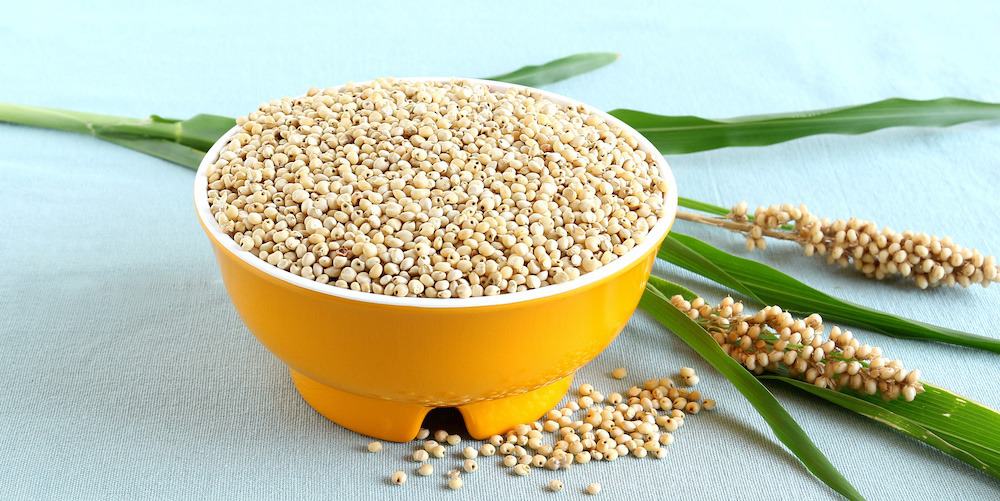SORGHUM BENEFITS
✓ Source of plant-based proteins
✓ Improves diabetes
✓ Relieves digestive issues
✓ Potentially anticancer
✓ Supports bone health
What is sorghum?
Sorghum is a plant in the grass family that includes cereals like wheat, barley, corn or oats. The genus Sorghum comprises around twenty varieties that are cultivated and used in different ways. Thus, one distinguishes forage sorghum, intended for animal feed, from grain sorghum, cultivated for its edible seeds. Common sorghum (Sorghum bicolor) is certainly the best-known variety.
This plant grows in all regions of Africa, where it thrives in the warm climate. Drought-resistant and not demanding of water, it has also spread to Australia, North and South America, India, and the Mediterranean basin.
In addition to being the world’s 5th most cultivated cereal, it is also one of the most nutritious. That’s why it is part of the staple diet of many populations.
Sorghum grains are an excellent source of fiber and plant-based proteins. In addition, they contain many minerals and trace elements, amino acids, vitamins, and antioxidants. Consuming sorghum can help manage diabetes and relieve digestive disorders. It also has anti-cancer potential and supports bone health.
Sorghum is considered a cereal of the future. Like the quinoa and the moringa, it helps fight malnutrition because it is nutritious and prevents nutritional deficiencies. In agriculture, it is positioned as an alternative to corn, much less demanding in water and fertilizers.
Nutritional composition
- Acides aminés
- Vitamines : B1, B2, B5, B6, E, PP
- Minéraux et oligo-éléments : fer, calcium, phosphore, magnésium, cuivre, potassium, manganèse, zinc
- Protéines
- Fibres
- Lipides
- Glucides
- Amidons
- Acides gras
- Actifs antioxydants : polyphénols, proanthocyanidines (lutéolinidine, apigéninidine)

Benefits of sorghum
🌿 Source of plant-based proteins
Sorghum grains provide a significant amount of plant proteins. They contain about 12 g of protein per 100 g. Sorghum thus joins the list of best foods for eating less meat while avoiding protein deficiencies. It is a cereal particularly suitable for vegetarians and vegans.
Moreover, its proteins provide many amino acids to the body, some of which are essential. Among them are leucine, threonine, phenylalanine, and valine. These amino acids are often present in low amounts in plant-based proteins.
This review by the Institute of Nutrition of Central America and Panama examined the composition of different sorghum varieties.
🍭 Improves diabetes
Thanks to its fiber content (about 3 g per 100 g), sorghum helps to reduce blood sugar levels. Indeed, its fibers slow carbohydrate absorption, prevent blood sugar spikes after meals and improve insulin sensitivity.
Grains also contain slowly digestible starches (SDS) which, unlike rapidly digestible starches (RDS), do not cause an immediate increase in blood glucose. They are slowly digested in the small intestine, between 20 and 120 minutes.
This study from the University of Arkansas (United States), conducted in humans, demonstrates the effectiveness of sorghum in controlling blood glucose and insulin levels.
♻️ Relieves digestive issues
Sorghum fibers also have beneficial effects on the digestive and gastrointestinal systems. Thus, consuming sorghum improves digestion, relieves diarrhea and bloating, and prevents gastric ulcers and colitis.
It also has a positive effect on the intestinal microbiota. It notably reduces populations of Clostridium bacteria, which are responsible for digestive disorders. At the same time, it increases the number of Lactobacillus, lactic acid bacteria that are probiotics.
This study from the University of Sao Paulo (Brazil), conducted in chickens, shows the benefits of sorghum on intestinal health.
🔬 Potentially anticancer
In various studies, sorghum has shown strong anti-cancer potential. Indeed, it contains antioxidant compounds that eliminate free radicals and protect the body’s cells.
It contains polyphenols, called « proanthocyanidins », which are themselves composed of luteolinidin and apigeninidin. These substances can inhibit the proliferation of cancer cells and induce their apoptosis (programmed cell death).
Moreover, it has an immunomodulatory effect: it increases the activity of natural killer (NK) cells and activates macrophages.
This study from the United States Department of Agriculture, conducted in the laboratory, demonstrates sorghum’s anti-cancer potential.
🦴 Supports bone health
Thanks to its high content of minerals and trace elements, sorghum supports bone health and prevents certain diseases such as osteoporosis, arthritis, and bone demineralization.
It contains notably magnesium (90 mg per 100 g) and calcium (25 mg per 100 g), which act synergistically to ensure bone strength. They also help consolidate and repair damaged bone tissue.
However, further studies are still needed to confirm sorghum’s beneficial effect on bone health.

How to consume sorghum?
Sorghum grains
Harvested in the fall, whole sorghum grains can then be cooked in water, like other cereals. Rinse the grains, immerse them in three times their volume of cold water, and bring to a boil. Cover and simmer over low heat for about 45 minutes.
Traditionally, the grains are prepared like rice, served with meat, fish or vegetables. You can also add them to soups and broths. Once cooked, they can also be incorporated into cold salads or used as a substitute for bulgur.

Sorghum flour
Sorghum flour has a sweet and slightly bitter flavor. Like buckwheat, rice or corn flour, it is naturally gluten-free and therefore suitable for people with celiac disease.
It is added to many preparations, at a level of up to 40%: breads, cookies and cakes, pasta, flatbreads…
Consume sustainably: prioritize local, organic, and fair-trade sorghum
✓ Sorghum is mainly cultivated in the United States, Mexico and Sudan. These countries alone supply 40 % of the world’s production. In recent years, its cultivation has also developed in France. It accounts for around 90,000 hectares, spread across the southwest, the Rhône and Loire valleys. It is appreciated for its ease of cultivation, its hardiness and its great resistance to drought.
✓ If you can, choose sorghum grown in France and organic farming. There are also fair-trade channels that support the work of small producers.
Dosage
There isn’t really a recommended dosage for sorghum. Simply consume it in moderation.
Contraindications and side effects
Sorghum consumption has no contraindications. However, it does contain dhurrine, a toxic substance. But it is mainly found in the leaves and the stalk and is present only in trace amounts in the grains. Dhurrine is then neutralized during cooking.
Its consumption presents some side effects:
- Maux de tête
- Flatulences
- Réaction allergique
If you experience side effects, stop consuming it and consult a doctor.
Sources and scientific studies
Leandro de Morais Cardoso, Soraia Silva Pinheiro, Hércia Stampini Duarte Martino, Helena Maria Pinheiro-Sant’Ana, 2017. Sorghum (Sorghum bicolor L.): Nutrients, bioactive compounds, and potential impact on human health.
E Tuna, R Bressani, 1992. Chemical composition of 11 varieties of sorghum (Sorghum vulgare) before and after popping the kernels.
Nicole M Poquette, Xuan Gu, Sun-Ok Lee, 2014. Grain sorghum muffin reduces glucose and insulin responses in men.
N S Fagundes, R Pereira, C Bortoluzzi, J M Rafael, G S Napty, J G M Barbosa, M C M Sciencia, J F M Menten, 2017. Replacing corn with sorghum in the diet alters intestinal microbiota without altering chicken performance.
Dmitriy Smolensky, Davina Rhodes, D Scott McVey, Zachary Fawver, Ramasamy Perumal, Thomas Herald, Leela Noronha, 2018. High-Polyphenol Sorghum Bran Extract Inhibits Cancer Cell Growth Through ROS Induction, Cell Cycle Arrest, and Apoptosis.



